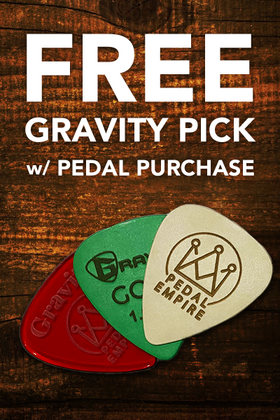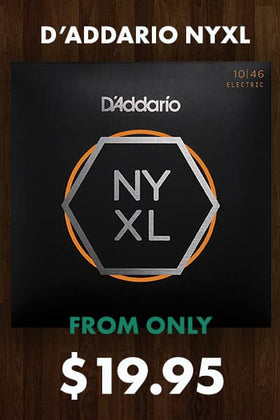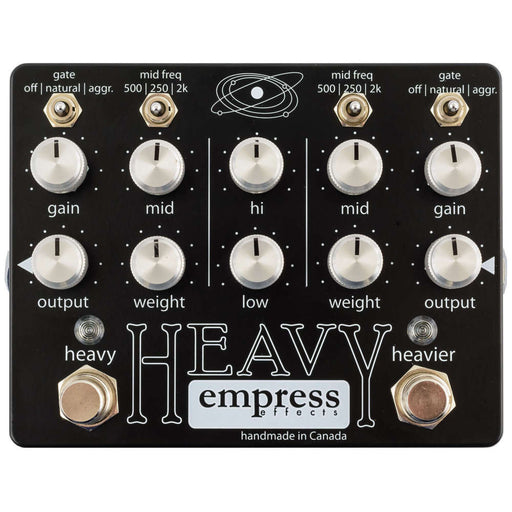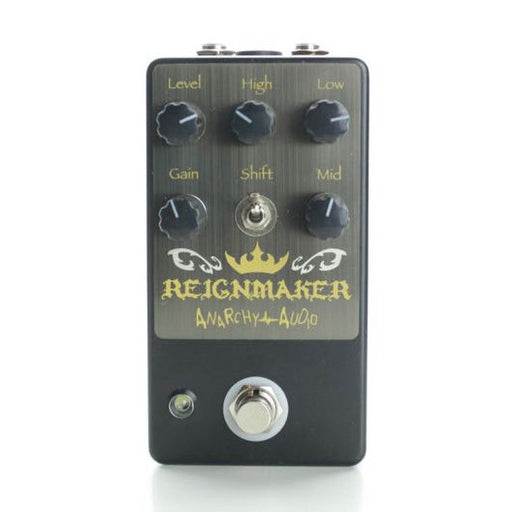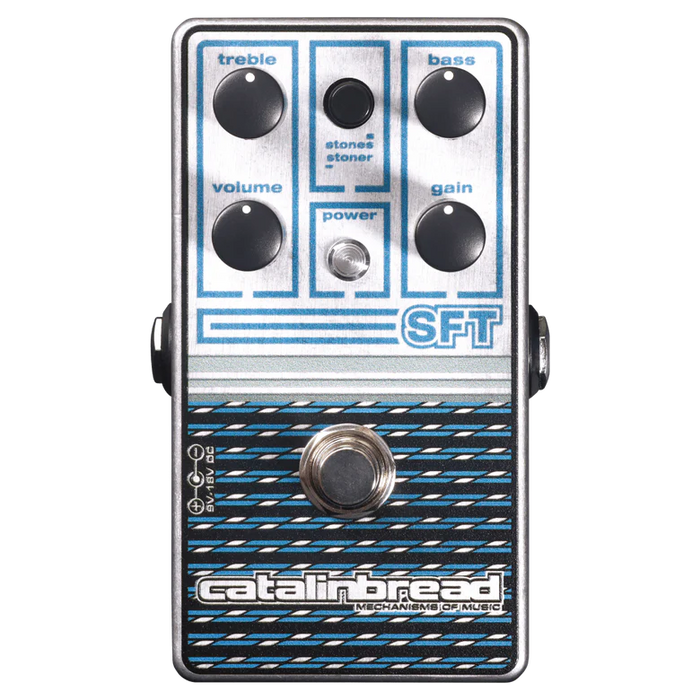

The SFT was a painstaking undertaking to accomplish. That elusive not-clean yet not-dirty sound. A great tube amp does it. You turn it up halfway or so and there it is – not totally clean but not really crunching either. It breathes. It bounces. It responds. Getting a pedal to do that is not easy. Getting a pedal to do that while also making the pedal able to become a pummeling JFET fuzz pedal is even harder. We persisted until we got there! It was all about gain staging. Finding the right bias points. Tuning the tone stack. Making the circuit resonate just right so the pick attack is right. So the thump of the low E string is right. When you’re finally done it seems obvious. Getting to obvious is not so obvious though!
EXPERIENCE
The SFT is one of our Foundation Overdrives – pedals can give you big, cranked up amp response at non-cranked volumes. To use it as intended, you’ll want your amp set to a relatively clean, flat response. In fact, the new SFT is our widest ranging Foundation pedal yet and responds particularly well to fuzzes, boosts, and overdrivers.
To get acquainted with your new SFT, let’s plug it in by itself, without your other pedals. Start off with a clean sound from your amp.
STONES/STONER MODES
First, let’s talk a bit more about the STONES/STONER MODE switch. This switch completely reconfigures the SFT and makes it become a completely new beast. Think Jekyll and Hyde! Two pedals in one! STONES MODE is super-refined and STONER MODE is raw and unleashed!
If you want the most authentic big Ampeg tube amp response, use STONES MODE. If you want a rippin’ high gain distortion sound that can achieve huge fuzz tones, use STONER MODE.
Since the SFT basically offers you two pedals in one, we’ll go through how the controls work for each mode.
STONES MODE
TREBLE/BASS knobs
Set to noon for a relatively flat response. Below noon to cut and above noon to boost. These are treble and bass shelving controls and have been carefully voiced for the SFT.
How do I control the midrange?
In Stones mode, setting all controls at noon will give you a flat response with a slight emphasis on the lower mids to give that big bodied Ampeg sound. To get more of a mid-hump response, try starting with Bass at 9:00 and Treble at noon. The Treble control is voiced to boost not only the highs but the upper mids as well so you can turn the Treble control up a bit to get more mids to crunch through. Try setting the Treble from noon to about 1:30 to boost some upper mids without increasing the treble too much. Also, turning the Gain control up will provide more push in the midrange as well.
And if you want to scoop the mids, just turn the Treble and Bass controls up. This is most effective when you run with lower Gain settings.
Range of BASS KNOB
Turning the Bass control down from noon gives a high-pass shelving response around 200hz. This allows you to tighten up the response and attenuate those woolly and woofy frequencies. Turning up the Bass control boosts all those frequencies. You’ll notice as the Bass control is turned towards maximum there will be a huge bump in low end. Huge. For most purposes that is too much boost of the low end! That huge amount of low end boost is there so you can crank it for the fuzz setting in Stoner mode.
Range of TREBLE KNOB
Turning the Treble control down from noon gives a low-pass shelving response at around 1000hz. Typically you’d turn the Treble down below noon in the following situations: you’ve got the Gain set low for clean response, you’re in Stoner mode dialing in a woolly fuzz tone, or you’re playing bass. Turning up the Treble control first gives you a nice kick in the upper mids from noon to 2:00 and then beyond that the sound will get increasingly more trebly. For most uses on guitar in Stones mode, you’ll probably find yourself setting the Treble from noon to 2:00.
GAIN KNOB
In STONES MODE, the range of the GAIN KNOB has been tuned to be very similar to that of the volume control on a big non-master volume tube amp. So, from minimum Gain to about 10:00, the response will be clean and bright. From 10:00 to noon, you’ll get edge-of-breakup response that is very sensitive to pick attack. From noon to 2:00, you’ll hit the overdrive sweet spot, just like that of most tube amps. And from 2:00 on, you’ll get increasing crunch and saturation.
Now, just like with real tube amps, the amount of overdrive you get with the SFT depends on the type of guitar you’re using. So, if you’re using a Fender-style guitar with vintage output pickups, you’ll have to turn up the Gain more to crunch it out or use a booster/fuzz pedal in front. Just like how you would with a real amp. Or, if you’re using something with a humbucker, you’ll have to turn the Gain down to get a cleaner response. Some guitars with high-output pickups may crunch out the pedal even with the Gain turned down. Just like with a real amp! Also, just like a real amp, SFT responds really well to turning your guitar’s volume down. So you can set the SFT up for a nice saturated crunch and clean up instantly by rolling your guitar volume back.
Also just like real non-master volume tube amps, you’ll find that you set the tone controls differently depending on where the Gain is set. If you’re going for a clean sound with the Gain set below noon, you might end up using less Treble but more Bass. And conversely, if you’re going for cranked up amp sound, you’ll find you’ll want to turn the Bass down and the Treble up to get a good crunch sound that cuts through the mix.
VOLUME KNOB
The SFT was designed to give a huge amount of output even with clean low gain settings. So, if you’re running the Gain control really low, you’ll find that there is plenty of output on the Volume knob to boost that clean sound quite loud! But if you’re running higher gain sounds, especially in Stoner mode, you’ll find that you won’t have to turn the Volume control up much at all.
STONER MODE
When you’re in STONER MODE, the controls still work basically the same way but you’ll find that you will run the TREBLE, BASS, and GAIN KNOBS lower than you would in Stones mode due to all the extra gain and frequency content.
And be forewarned! In STONER MODE, turning up the controls to extreme settings will result in extreme sounds and potentially noise! If you want tighter distortion sounds in STONER MODE, just start with the TREBLE, BASS, and GAIN KNOBS at the lower settings and go from there. Also, don’t forget about the Volume and Tone controls on your guitar. You can use those to tame Stoner mode and still have room to unleash the beast when it’s time.
Warranty & Returns
All New products are covered by the manufacturers new warranty. Please check their website for the length of warranty and warranty conditions. If an item you receive is faulty get in touch with us ASAP. Second Hand products come with a 4 week warranty from us. If there is an issue let us know ASAP! This covers normal use and does not cover accidental damage, misuse, wrong power plugged into it, modding, water damage or any other damage caused by mistreatment. Just treat it nice and all will be good!
Shipping
We send A LOT of packages every week so don't worry about the shipping side of things!
We've never lost a thing and your awesome new gear will be packed up really well to avoid any damage in transit.
If your order comes in before 2pm we will ship it same day. Most of the time we pack things up all the way to 4pm so just call if you need it to leave same day after 2pm.
We ship mainly with Australia Post but may use a courier depending on location and size of the package.
Free Post ships with Australia Post standard and expected shipping times are between 4-6 business days depending on location. It will be longer to outside of metro and rural areas.
Express Post will usually be with you next business day in metro areas of QLD, NSW, SA, VIC and TAS. WA will take 2 days to metro and extra days after that to out side metro and rural areas.
Everything we ship has a tracking number with the exception of some power cables and smaller envelope packages. You will be emailed tracking once your order has been shipped!
The SFT was a painstaking undertaking to accomplish. That elusive not-clean yet not-dirty sound. A great tube amp does it. You turn it up halfway or so and there it is – not totally clean but not really crunching either. It breathes. It bounces. It responds. Getting a pedal to do that is not easy. Getting a pedal to do that while also making the pedal able to become a pummeling JFET fuzz pedal is even harder. We persisted until we got there! It was all about gain staging. Finding the right bias points. Tuning the tone stack. Making the circuit resonate just right so the pick attack is right. So the thump of the low E string is right. When you’re finally done it seems obvious. Getting to obvious is not so obvious though!
EXPERIENCE
The SFT is one of our Foundation Overdrives – pedals can give you big, cranked up amp response at non-cranked volumes. To use it as intended, you’ll want your amp set to a relatively clean, flat response. In fact, the new SFT is our widest ranging Foundation pedal yet and responds particularly well to fuzzes, boosts, and overdrivers.
To get acquainted with your new SFT, let’s plug it in by itself, without your other pedals. Start off with a clean sound from your amp.
STONES/STONER MODES
First, let’s talk a bit more about the STONES/STONER MODE switch. This switch completely reconfigures the SFT and makes it become a completely new beast. Think Jekyll and Hyde! Two pedals in one! STONES MODE is super-refined and STONER MODE is raw and unleashed!
If you want the most authentic big Ampeg tube amp response, use STONES MODE. If you want a rippin’ high gain distortion sound that can achieve huge fuzz tones, use STONER MODE.
Since the SFT basically offers you two pedals in one, we’ll go through how the controls work for each mode.
STONES MODE
TREBLE/BASS knobs
Set to noon for a relatively flat response. Below noon to cut and above noon to boost. These are treble and bass shelving controls and have been carefully voiced for the SFT.
How do I control the midrange?
In Stones mode, setting all controls at noon will give you a flat response with a slight emphasis on the lower mids to give that big bodied Ampeg sound. To get more of a mid-hump response, try starting with Bass at 9:00 and Treble at noon. The Treble control is voiced to boost not only the highs but the upper mids as well so you can turn the Treble control up a bit to get more mids to crunch through. Try setting the Treble from noon to about 1:30 to boost some upper mids without increasing the treble too much. Also, turning the Gain control up will provide more push in the midrange as well.
And if you want to scoop the mids, just turn the Treble and Bass controls up. This is most effective when you run with lower Gain settings.
Range of BASS KNOB
Turning the Bass control down from noon gives a high-pass shelving response around 200hz. This allows you to tighten up the response and attenuate those woolly and woofy frequencies. Turning up the Bass control boosts all those frequencies. You’ll notice as the Bass control is turned towards maximum there will be a huge bump in low end. Huge. For most purposes that is too much boost of the low end! That huge amount of low end boost is there so you can crank it for the fuzz setting in Stoner mode.
Range of TREBLE KNOB
Turning the Treble control down from noon gives a low-pass shelving response at around 1000hz. Typically you’d turn the Treble down below noon in the following situations: you’ve got the Gain set low for clean response, you’re in Stoner mode dialing in a woolly fuzz tone, or you’re playing bass. Turning up the Treble control first gives you a nice kick in the upper mids from noon to 2:00 and then beyond that the sound will get increasingly more trebly. For most uses on guitar in Stones mode, you’ll probably find yourself setting the Treble from noon to 2:00.
GAIN KNOB
In STONES MODE, the range of the GAIN KNOB has been tuned to be very similar to that of the volume control on a big non-master volume tube amp. So, from minimum Gain to about 10:00, the response will be clean and bright. From 10:00 to noon, you’ll get edge-of-breakup response that is very sensitive to pick attack. From noon to 2:00, you’ll hit the overdrive sweet spot, just like that of most tube amps. And from 2:00 on, you’ll get increasing crunch and saturation.
Now, just like with real tube amps, the amount of overdrive you get with the SFT depends on the type of guitar you’re using. So, if you’re using a Fender-style guitar with vintage output pickups, you’ll have to turn up the Gain more to crunch it out or use a booster/fuzz pedal in front. Just like how you would with a real amp. Or, if you’re using something with a humbucker, you’ll have to turn the Gain down to get a cleaner response. Some guitars with high-output pickups may crunch out the pedal even with the Gain turned down. Just like with a real amp! Also, just like a real amp, SFT responds really well to turning your guitar’s volume down. So you can set the SFT up for a nice saturated crunch and clean up instantly by rolling your guitar volume back.
Also just like real non-master volume tube amps, you’ll find that you set the tone controls differently depending on where the Gain is set. If you’re going for a clean sound with the Gain set below noon, you might end up using less Treble but more Bass. And conversely, if you’re going for cranked up amp sound, you’ll find you’ll want to turn the Bass down and the Treble up to get a good crunch sound that cuts through the mix.
VOLUME KNOB
The SFT was designed to give a huge amount of output even with clean low gain settings. So, if you’re running the Gain control really low, you’ll find that there is plenty of output on the Volume knob to boost that clean sound quite loud! But if you’re running higher gain sounds, especially in Stoner mode, you’ll find that you won’t have to turn the Volume control up much at all.
STONER MODE
When you’re in STONER MODE, the controls still work basically the same way but you’ll find that you will run the TREBLE, BASS, and GAIN KNOBS lower than you would in Stones mode due to all the extra gain and frequency content.
And be forewarned! In STONER MODE, turning up the controls to extreme settings will result in extreme sounds and potentially noise! If you want tighter distortion sounds in STONER MODE, just start with the TREBLE, BASS, and GAIN KNOBS at the lower settings and go from there. Also, don’t forget about the Volume and Tone controls on your guitar. You can use those to tame Stoner mode and still have room to unleash the beast when it’s time.
Warranty & Returns
All New products are covered by the manufacturers new warranty. Please check their website for the length of warranty and warranty conditions. If an item you receive is faulty get in touch with us ASAP. Second Hand products come with a 4 week warranty from us. If there is an issue let us know ASAP! This covers normal use and does not cover accidental damage, misuse, wrong power plugged into it, modding, water damage or any other damage caused by mistreatment. Just treat it nice and all will be good!
Shipping
We send A LOT of packages every week so don't worry about the shipping side of things!
We've never lost a thing and your awesome new gear will be packed up really well to avoid any damage in transit.
If your order comes in before 2pm we will ship it same day. Most of the time we pack things up all the way to 4pm so just call if you need it to leave same day after 2pm.
We ship mainly with Australia Post but may use a courier depending on location and size of the package.
Free Post ships with Australia Post standard and expected shipping times are between 4-6 business days depending on location. It will be longer to outside of metro and rural areas.
Express Post will usually be with you next business day in metro areas of QLD, NSW, SA, VIC and TAS. WA will take 2 days to metro and extra days after that to out side metro and rural areas.
Everything we ship has a tracking number with the exception of some power cables and smaller envelope packages. You will be emailed tracking once your order has been shipped!

